Propane Tank Safety: Here’s What Every RV Owner Should Know
Every RVer is familiar with propane. It cools our fridges, cooks our food, heats our rig, and for some, it runs their generator. Like all combustible fuels, it has its dangers. Propane tank safety goes beyond just fire prevention, though.
The following article will provide in-depth information about propane tank safety, like inspecting your tanks, hoses, regulator, and vents regularly. It will address propane tank safety equipment needed to keep you and your family safe on the road and answer the question Should you drive with the propane on or off? Finally, you will get an honest review of a new propane tank safety product called the GasStop.
What is propane?
Propane, or Liquified Petroleum Gas (LPG), is a portable, clean, and efficient energy source worldwide. Almost all of the propane used in the United States comes from the U.S.
It is considered green energy because of its low emissions compared to other types of fossil fuels. If spilled, it is released as a gas, meaning it won’t spill or leave a residue on land or waterways. The only real downside to propane is, like all other fossil fuels, it is a finite resource.
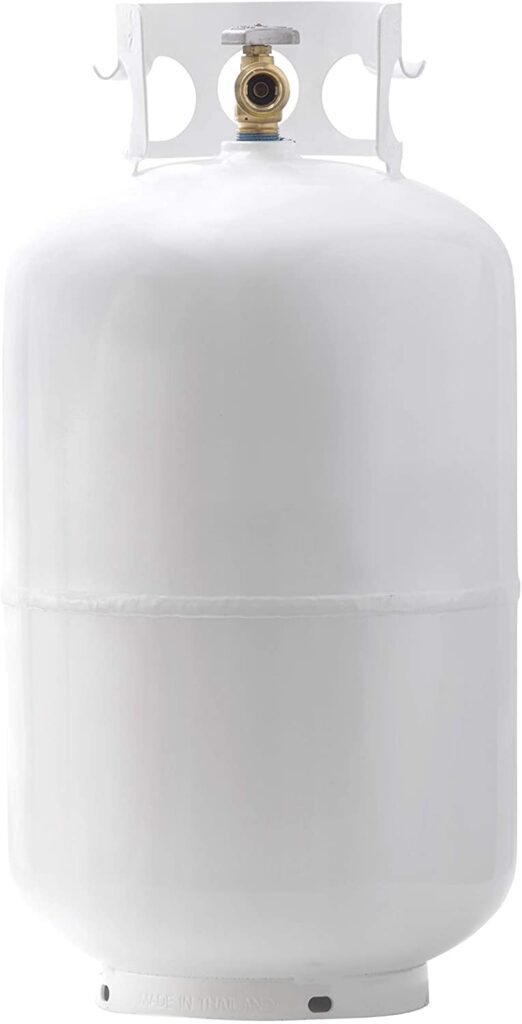
Propane storage and transportation
Propane is a gas at normal atmospheric pressure down to about -44 degrees Fahrenheit. That makes it an attractive fuel even when temperatures plummet. It is not very portable in its gaseous state, though. Fortunately, it can be turned into a liquid at higher temperatures by putting it under pressure. At just about 125 psi, propane will condense into a liquid at 80 degrees Fahrenheit. Most propane tanks have an internal pressure of between 120 and 200 psi.
Liquid propane is the ideal storage and transportation method for propane because you can fit so much in a small space. One gallon of liquid propane weighs 4.23 pounds, will produce 270 gallons of propane gas, and holds about 91,000 BTUs. In other words, a 30,000 BTU RV furnace will be able to run continuously for roughly 3 hours on one gallon of liquid propane.
Propane is stored in steel propane tanks. They come in many different sizes, but 20-pound and 30-pound tanks are the most common among towable RVs.
Motorhomes have the tank permanently mounted to their frame. RVers that own fifth wheels and travel trailers can remove their propane tanks to get them filled, while motorhomes must be driven to the propane filling station. Motorhome users can install a brass tee like the one shown in the video below, allowing them to use a portable tank when stationary.https://www.youtube.com/embed/eXLzByAu9ms?feature=oembedInstalling an RV 4-port Brass Tee
Liquid propane is dangerous
For liquid propane to turn into gas, it absorbs heat from the air outside the tank. If you feel the bottom of a tank while something is running, it will feel colder than the tank’s top. This process is slow with the controlled flow of a gas burner.
However, if the liquid propane were to leak or spray out for some reason, it would rapidly absorb the heat from whatever it touched. Any surfaces liquid propane spills on can rapidly drop -44 degrees in a matter of seconds. If liquid propane spills onto your skin, it can cause severe frostbite injuries.
The two most plausible scenarios that could cause a consumer to come in contact with liquid propane are a ruptured tank or having the propane bottle in an improper position.
RV Propane Tank Safety Tip #1 – Keep the tank in the proper position
You should always keep portable tanks like those on travel trailers, fifth wheels, and other towable RVs in the upright position with the valve’s handle on the top. When a propane bottle is turned on, the liquid at the bottom of the bottle boils, creating pressurized propane gas at the top. The gas is pushed out the top of the bottle and fed to your propane system.
If your portable bottle is sideways or even upside down, the gas’s pressure will force liquid propane out of the bottle. Pushing liquid propane into a system designed for vapor can damage the components. It is essential to always keep your propane tanks in the upright position, especially while using them.
Most towable RVs have specific locations meant to strap the propane bottles in place in the upright position. It may be worth noting that you should transport propane bottles in the proper position even while not in use.
Motorhome users who use a propane brass 4-port tee to hook up an external tank will not have a place to strap down their tank. When setting tanks on the ground or any other surface, make sure that the portable tanks are stable and on level ground to avoid the tanks from falling over.
You can get a plastic stabilizing base to set the propane tank to widen the tank’s footprint and make it more stable. Some RVers will use plastic milk crates for this purpose.

RV Propane Tank Safety Tip #2 – Inspect your tank
Steel tanks hold pressure pretty well unless they are compromised. Inspect your tank regularly for rust and corrosion. If you have a motorhome, you will want to also inspect the mounting hardware for wear and rust along with the tank.
Rust is the process of oxygen breaking down the iron in the steel into iron oxide. That means, as rust builds up, you lose more and more of the metal, which can weaken the tank over time, causing it to fail. So there really should be no rust on a tank, and you should take care of even superficial rust as soon as possible.
Another thing you should look for is any unusual bulges and large dents. If the tank bulges out, that indicates that the integrity has been compromised and is at risk of failure. If your tank has any visible dents, you should also consider it compromised. The compromised tank should be taken to a qualified propane technician to be inspected. It may need to be taken out of service.
Should you paint your tank?
Repainting a tank with a rust preventing paint is an excellent way to stop rust from progressing. Whether or not you should paint the tank yourself is, for the most part, a personal choice. Many tutorials on the internet tell you how to paint propane tanks for both motorhomes and towable RVs. It is not tricky. The cautionary note is that you don’t want to cover up potential problems.
If you are painting your tank because it has a lot of rust, take your tank to a qualified service technician to be inspected before covering anything up. They can tell you if the rust has caused any serious problems, give you advice on what to use if you want to repaint it yourself, or for a price, they may repaint your propane tank for you.
Propane Tank Safety Tip #3 – Requalify your tanks
As of this writing, propane tanks must be requalified 12 years after the date of manufacture. You can find that date stamped onto the collar of the bottle. After the first 12 year period, tanks must at least get a visual inspection. Then they are suitable for another five years.
All requalification dates will be stamped on the collar of the bottle as well. There may be several, so you have to find the most recent one. Use the photos below to reference what a manufacturer’s date stamp looks like compared to a requalification stamp.
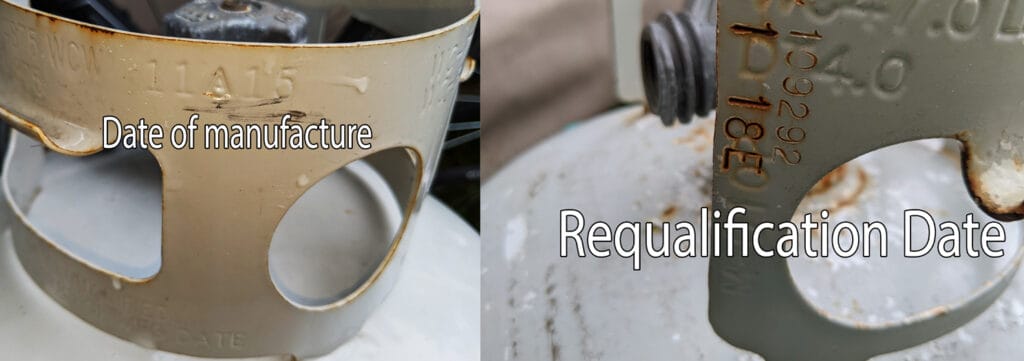
Motorhome exceptions
The propane tanks mounted to motorhomes are made slightly different and not subject to the same inspection laws as portable DOT tanks. They are known as ASME tanks because the American Society of Mechanical Engineers approves them. These tanks do not require you to requalify them.
Inspecting ASME tanks yourself is a definite RV maintenance task. You can also take your RV to a service location that provides propane LP inspection service. Many RV service locations offer LP system inspections. They will not only look at your tanks, but they will also inspect the entire propane system’s function, which is the next tip on the list.
RV Propane Tank Safety Tip #4: Inspect hoses and vents
Keeping your tanks in working order is essential, and inspecting them periodically or before each RV trip is a must. You will want to examine all of the visible hoses that go from your tank to your RV. Road debris, weather, and old age can be damage the hoses.
Trace the lines from your propane tanks as far as you can, looking for any cracking or damage. Sometimes these hoses can develop micro leaks, which get worse over time. The GasStop is an excellent propane safety device that, among other things, allows you to check for minor propane leaks yourself. More about that later.
In addition to looking at all visible propane hoses, you will want to inspect any vents periodically for debris, insects, or other small animals. Wasp nests, mice nests, and other propane vent obstructions can create a huge fire hazard. There are three typical locations that propane vents outside your RV.
Heating system vent
The heating system vent is located on the side of the RV and can be easily spotted due to the size of the hole or holes. Look down the vent with a flashlight. Make sure the propane heater is off before you do this, so you don’t get burned. You are checking for any foreign objects that you can see.
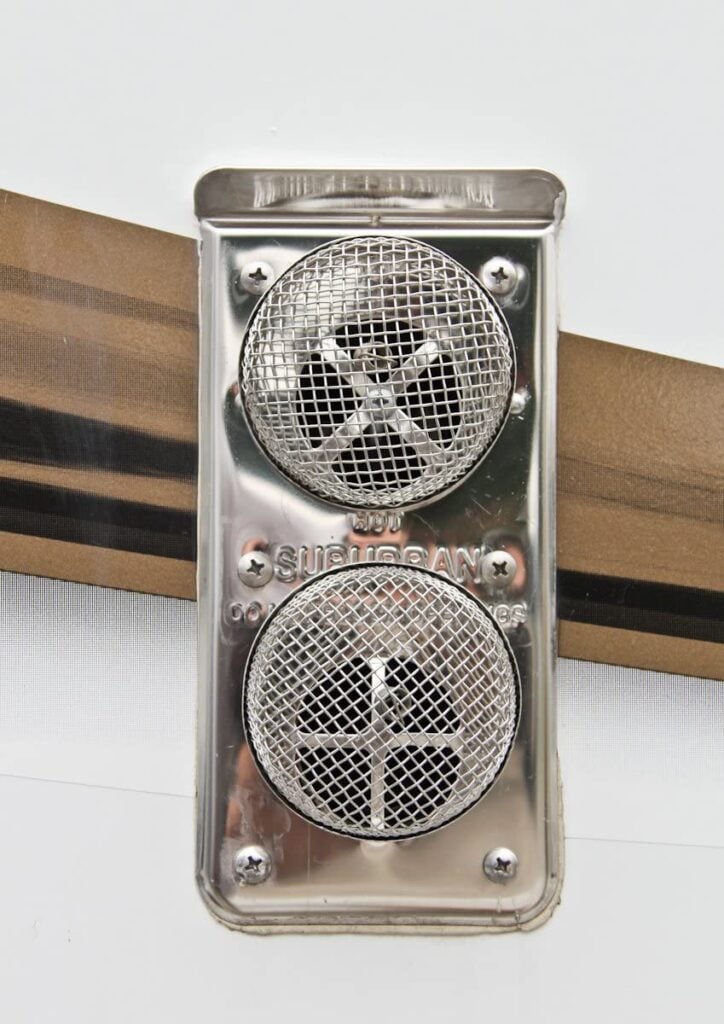
Water heater vent
RV water heaters will typically have a square access cover with a metal vent on it. Like the heater vent, insects may be able to access the space and make a home there.
You should check for any debris and evidence of nests by opening the water heater compartment’s square cover. Again, make sure you do not have the propane or water heater on when you do this.
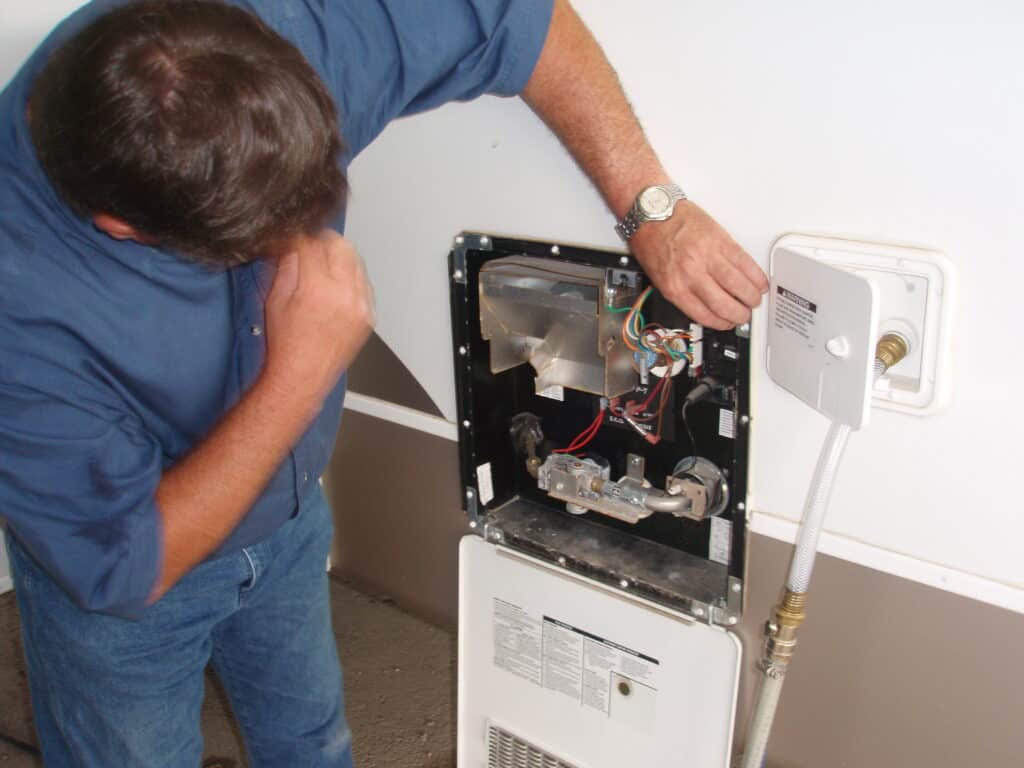
Refrigerator vent
The refrigerator vent is also on the side of your RV and is found directly behind your refrigerator. RV owners should remove these vent covers and keep the area free from debris.
Most of the propane vents listed above will be regularly run if you are a full-time RVer. The refrigerator vents should be removed and checked as part of your regular maintenance routine, even if you live in your RV full time.
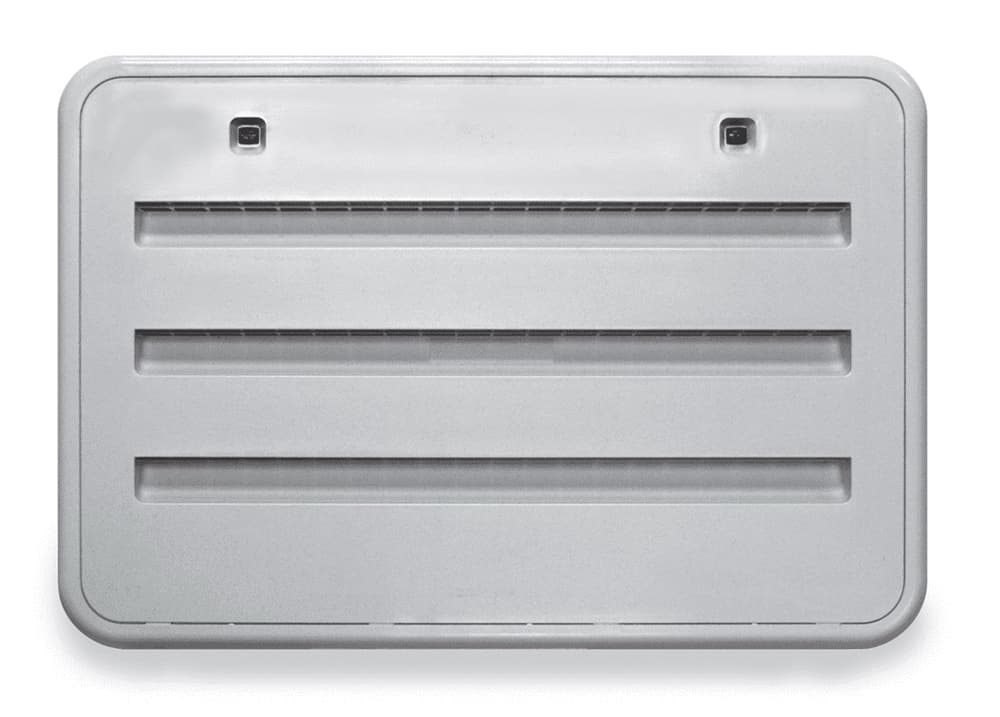
Make sure the propane is off before doing this. If you are plugged in and running your fridge off electricity, the back cooling unit can get very hot, so be cautious before touching anything.
RV Propane Tank Safety Tip #5: Propane regulator
If you attempted to run propane directly from your tank to your cooktop, 120 to 200 psi would cause more of a flame thrower rather than a cooking flame. The propane regulator’s job is to regulate the pressure of propane from the tank to something usable.

You can easily find the propane regulator by looking around where your propane tank is attached to the RV propane system. The photo below shows the typical placement of a propane regulator on a towable RV and a motorhome.
There isn’t too much to inspect when it comes to the regulator. As long as it doesn’t look damaged and is free from dirt and road grime, it should provide years of reliable service.
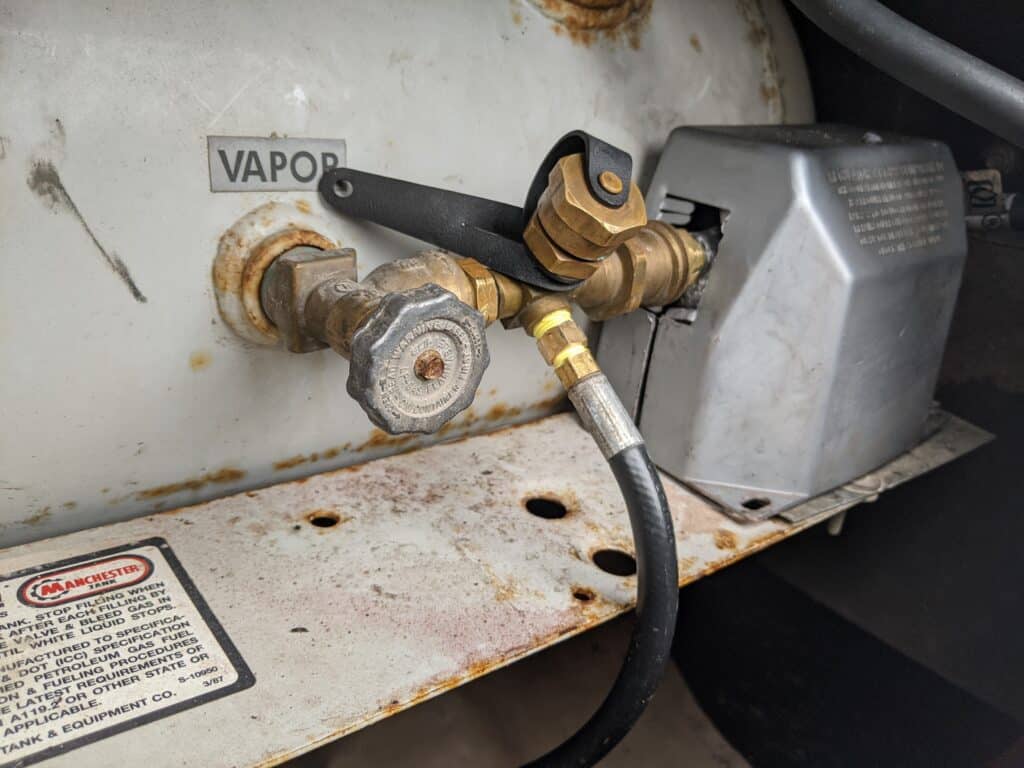
If you notice the propane won’t work or the flames on your burner are yellow instead of blue, it may be a sign of your propane regulator failing. New regulators generally don’t fail unless damaged somehow. Still, propane regulators have a shelf life and should be replaced after 10-15 years of service.
Replacing a regulator can be done at most RV service locations. It is not difficult to replace a propane regulator yourself, either. The following videos show how to replace propane regulators for both a towable RV and a motorhome.https://www.youtube.com/embed/IKlgwqOJohU?feature=oembedReplacing LP hoses and regulator on a fifth wheel.https://www.youtube.com/embed/P0ZjbdSMEEE?feature=oembedReplacing a propane regulator in a motorhome.
RV Propane Tank Safety Tip #6: Drive with the propane on or off
If there was such a thing as an RV bar with the attitude of a biker bar, walking in and declaring that you had the definitive answer to this question would be an excellent way to start an argument or bar fight. First off, why would you want to keep the propane on while traveling? When not plugged into power, RV refrigerators run on propane, and keeping it on while you travel keeps your food cold.
The answer to whether you can run the propane fridge while driving down the road is yes, it’s possible to do so. The question of whether you SHOULD is a personal choice. You are increasing the risk of fire by running your fridge on propane while driving, but there is no way to calculate that risk. If you choose to drive with the propane on while driving, know that you are accepting that risk.
Note: Some bridges, tunnels, and ferries require your propane to be off, and it is required by law to have your propane off while filling at a gas station. Here is a more in-depth look at this topic so you can make an informed decision as to what you want to do
RV Propane Tank Safety Tip #7: Propane safety equipment
In cars, we have seatbelts. For bikes, we have helmets. Every activity with an inherent risk requires equipment designed to minimize that risk. RVs have several types of propane safety equipment.
Carbon monoxide detector (Required by law)
Carbon monoxide gas (CO) is an odorless, colorless, and tasteless gas. It is produced when you burn many fuels. When your system is functioning correctly, propane is a rather clean-burning gas. Generally, it emits little CO. If, however, your propane system is not working correctly, you will get an incomplete burn, which causes CO to be produced in higher quantities.
It is possible to fill an RV with lethal amounts of CO before you even know it because it is odorless. Even small amounts of CO exposure over time can have devastating effects on the human body. It is crucial to have a working CO detector. Most of them look like a smoke detector and should be tested once a month using the test button. CO is lighter than air, so the detector should be mounted high up in your RV.
Some RVs have CO detectors wired into the 12V system, and others are battery operated. All have an expiration date of 5 to 7 years, so check the date on yours and replace it as necessary.
Smoke detectors (Required by law)
The National Fire Protection Association (NFPA) estimates that 20,000 RV fires occur annually. A working and current smoke detector is recommended in an RV and required by law.
Like the CO detector, smoke alarms should be tested once a month and replaced when out of date. Smoke detectors can be overlooked but an RV can burn to the ground in under ten minutes, especially if fueled by a significant propane leak.
Fire extinguisher
All RVs are required to have a working fire extinguisher to be sold. They are generally located next to the door of the RV. You should not only know where it is, but you should know how to use it. If you are purchasing a fire extinguisher, make sure it is at least a B:C type extinguisher. Check out The Complete Guide To RV Fire Extinguishersfor more information and a list of suitable RV fire extinguishers to get.
Propane alarm
Because it is odorless and colorless, propane companies add a harmless chemical called mercaptan to give it the distinct rotten egg smell. However, propane is heavy and settles to the bottom of the RV if the air isn’t disturbed. That is why propane alarms are placed low to the ground and can detect the propane long before your nose will.
It is essential to have a propane detector because if gas is leaking into your RV, sparks from switches or other ignition sources could set it off. Propane can also replace much of the oxygen in the air, causing suffocation.
Just like the other alarms above, you will want to test this alarm monthly and replace it when it expires. Each model will have a slightly different shelf life, and the expiration date should be written on the alarm.
RV Propane Tank Safety Tip #8: The GasStop Device
Propane leaks are one of the leading propane safety concerns when it comes to RVing. Major leaks from accidents or road hazards such as tire blowouts can have explosive consequences.
Small leaks can fill a space with propane and be ignited with sparks created by a light switch or plugging in an appliance. Maintenance will help prevent leaks from happening, but sometimes they happen.
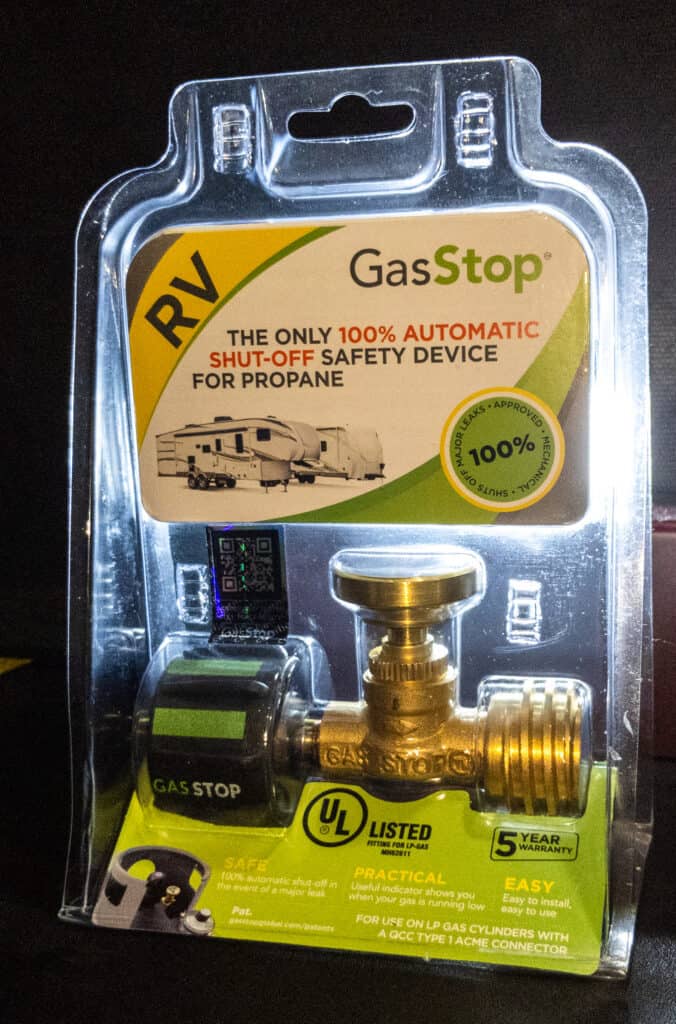
The GasStop is a device that attempts to make propane leaks even less likely to happen by acting as an automatic shutoff valve in the case of a major propane leak. It can also be used to find minor propane leaks and has an active propane gauge.
My honest GasStop review
GasStop sent me two units to test out and review on my RV. I have a motorhome and use a brass tee when stationary. So I was able to install and test both types that they offer for RVers. Before attempting to install either type of GasStop, I made sure to turn my propane off.
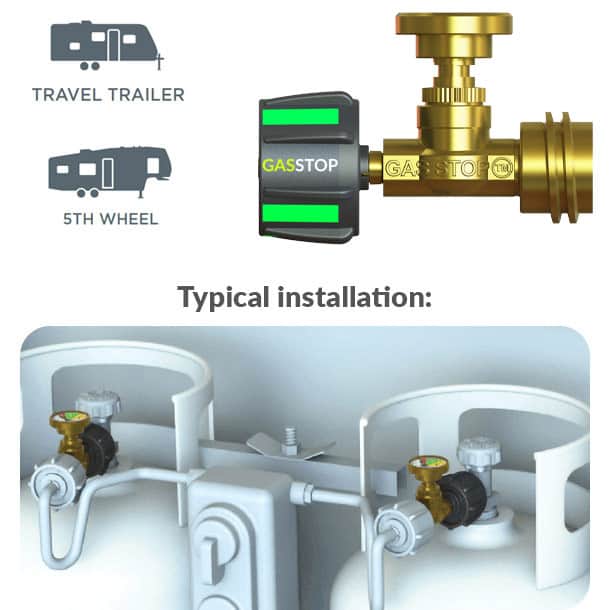
Installation
The ACME connection type for portable bottles that you find on fifth wheels and travel trailers was easy to install. You simply screw it onto the tank and then attach your propane hose to the end of the GasStop.
The POL connection took a little more doing. Many motorhome regulators are pinned down to the tank collar with a plastic cover. It is important to have the plastic cover to keep dirt and debris away from the regulator while driving.
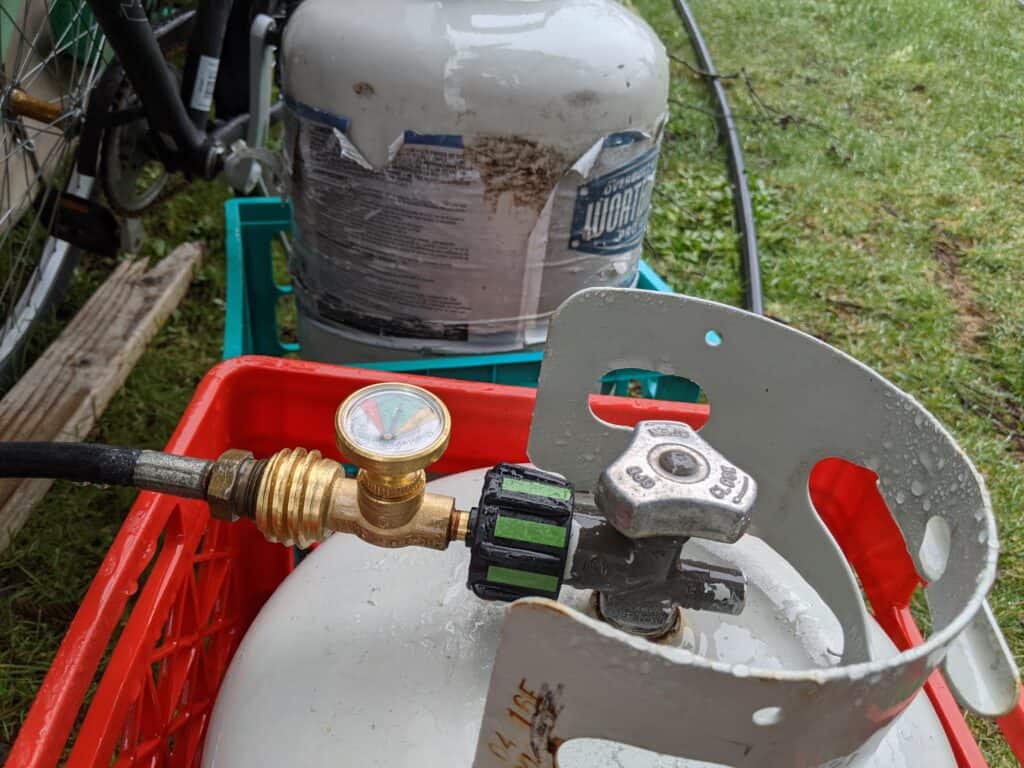
I had already added a metal plate and moved my propane regulator to install my 4-port brass tee for external tank hookups. Below are the before and after photos.
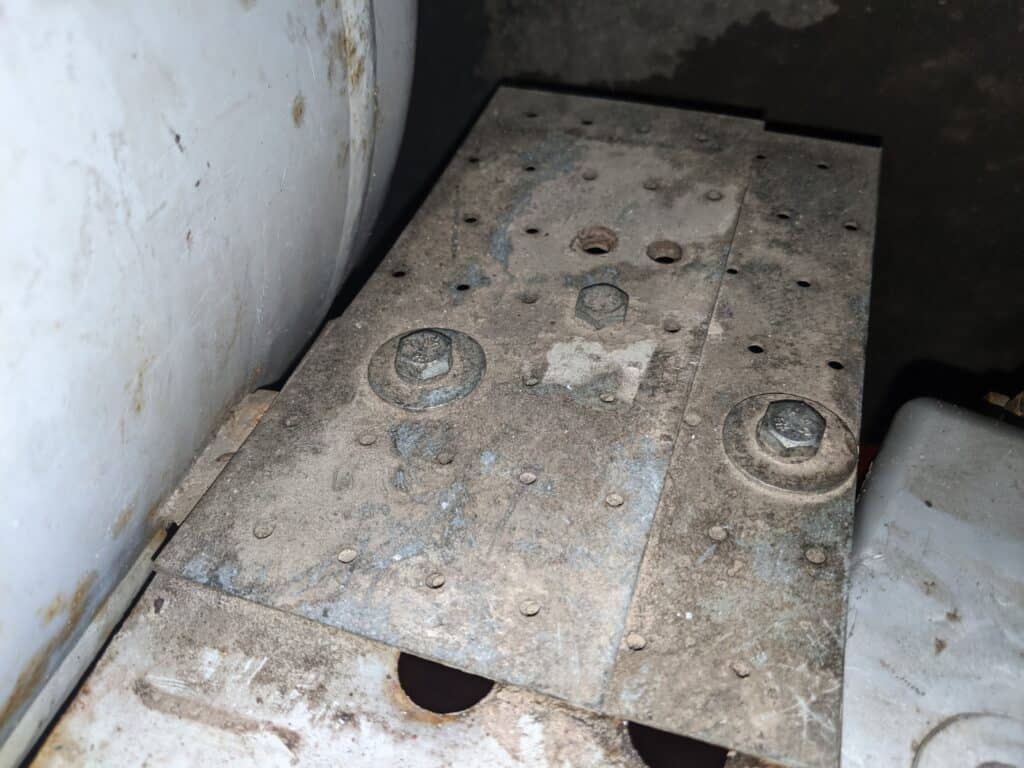
The concept of installing the GasStop was the same for the POL connection, though. Unscrew the regulator from the tank, screw the GasStop into the tank, and then screw the regulator into the GasStop.
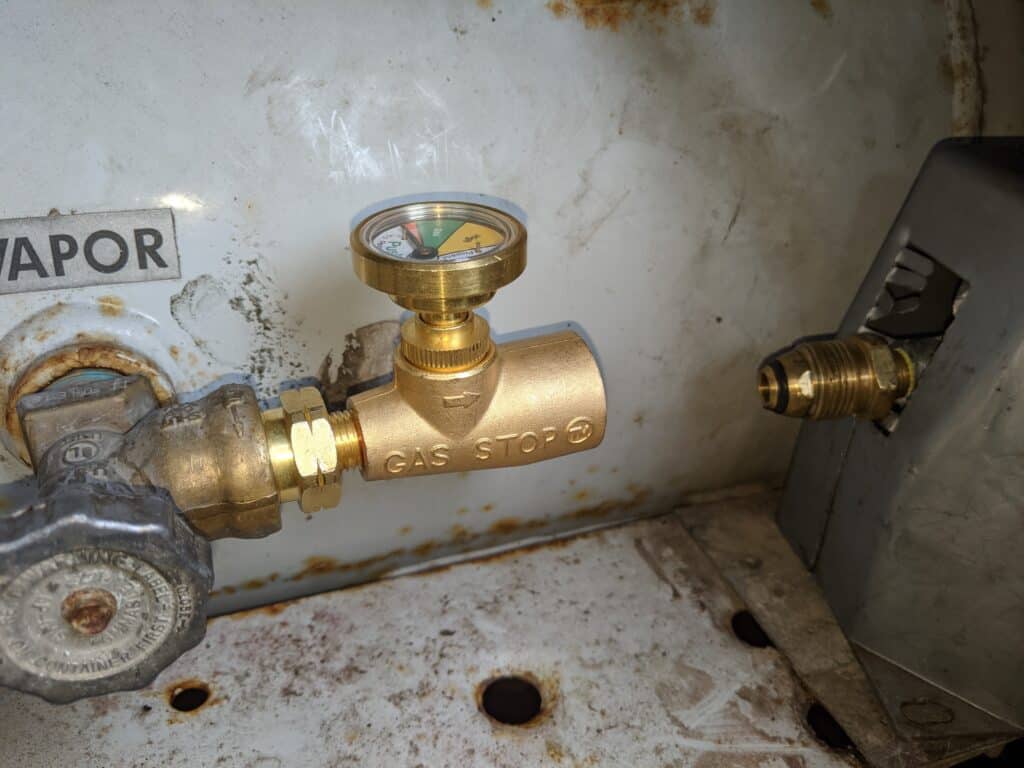
Overall, installing both the ACME and POL connections was straightforward, easy, and only took minutes.
Testing the GasStop
The company claims the GasStop can be used as an active pressure gauge, a minor leak tester, and of course, it should shut off the gas entirely in the event of a major leak.
Active Pressure Gauge Test
To test this, I checked the gauge every two days as I used propane to heat my RV for a couple of weeks. Overall the meter did an excellent job of showing when the propane was running low.
The fact that the pressure gauge is active pressure is an advantage too. I was able to not only see that I had propane, but I could see that the pressure was steady as I ran various things. This told me that my regulator and propane system appeared to be functioning correctly.
Minor leak test
According to the instructions that come with the unit, you can test for minor leaks by turning the propane on, priming the unit by pressing the gauge 5 to 6 times, then turning the propane tank off. You then note the needle’s exact position on the gauge and wait for 1 to 5 minutes. If the needle goes down, there is a leak somewhere. If it doesn’t move, you are good to go.
After installing my GasStop, I unscrewed one of the hoses on my propane system just enough to cause a small leak. I used propane leak detector fluid to determine it was leaking slightly. I followed the instructions that came with both the POL and ACME versions of the GasStop, and it worked as advertised.
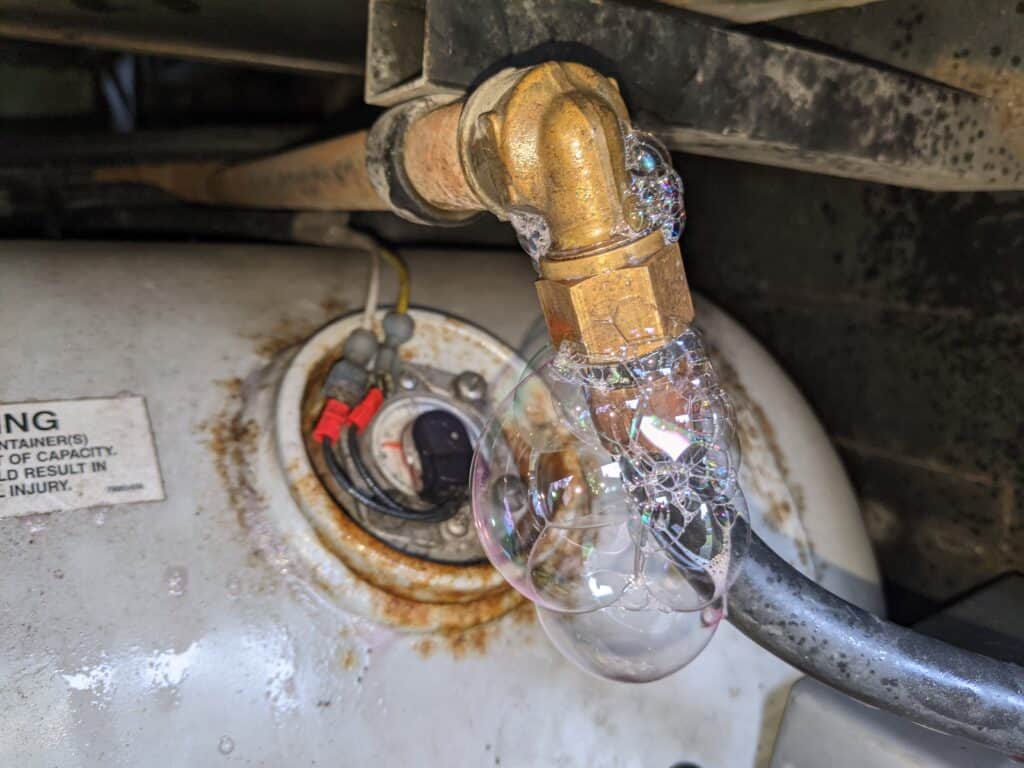
Quick Story: I once had my propane tanks filled and some of the smell transferred onto my gloves when I was carrying the tank back to my car. I got back to the RV, hooked the propane tank up, and set my gloves on the counter inside. Being outside, I didn’t realize my gloves were that strong smelling. After a few minutes inside, my wife noticed the smell.
I didn’t want to take any chances, so I immediately went out to check all of the connections and sprayed soapy water over everything. The smell persisted, but I couldn’t find any leaks. Ultimately, my wife discovered the gloves as the source. It feels good knowing that I now have a measurable and visible way to see if my propane system leaks anywhere.
Major propane leak shutoff test
At one point, a check valve in my 4-port brass tee went bad while traveling down the road. About 60 miles and over half a tank of propane later, I discovered the leak when I stepped out of my rig.
Imagine if I didn’t step out? Perhaps a spark could have ignited it when I turned on the engine. The chance of that happening may have been 1 in 1000, but it wasn’t zero.
With that story in mind, you might see how I was hoping this device lived up to its name. There was only one way to find out; I needed a major propane leak in my system.
Before I go further in talking about testing this product, I want to state that I was wearing safety equipment, safety glasses, and gloves. I made sure all pilot lights and propane appliances were off as well. Purposely causing leaks and disconnecting things while the propane is still on is probably not the best of ideas. Someone has to do the stupid stuff, so you don’t have to, and I volunteered. You’re welcome.
For the final test, I turned the propane on, primed the GasStop, and made sure all was working. I found a connection located beyond the output side of the regulator that I could disconnect and quickly unscrewed it.
I heard a short hiss, followed by nothing. Upon looking at the gauge, I found that the GasStop performed exactly as it should have. I tested this with both the ACME GasStop on my external tank connected to a 4-port brass tee and the POL GasStop connected to my motorhomes mounted tank several times. Each time the GasStop worked as advertised.
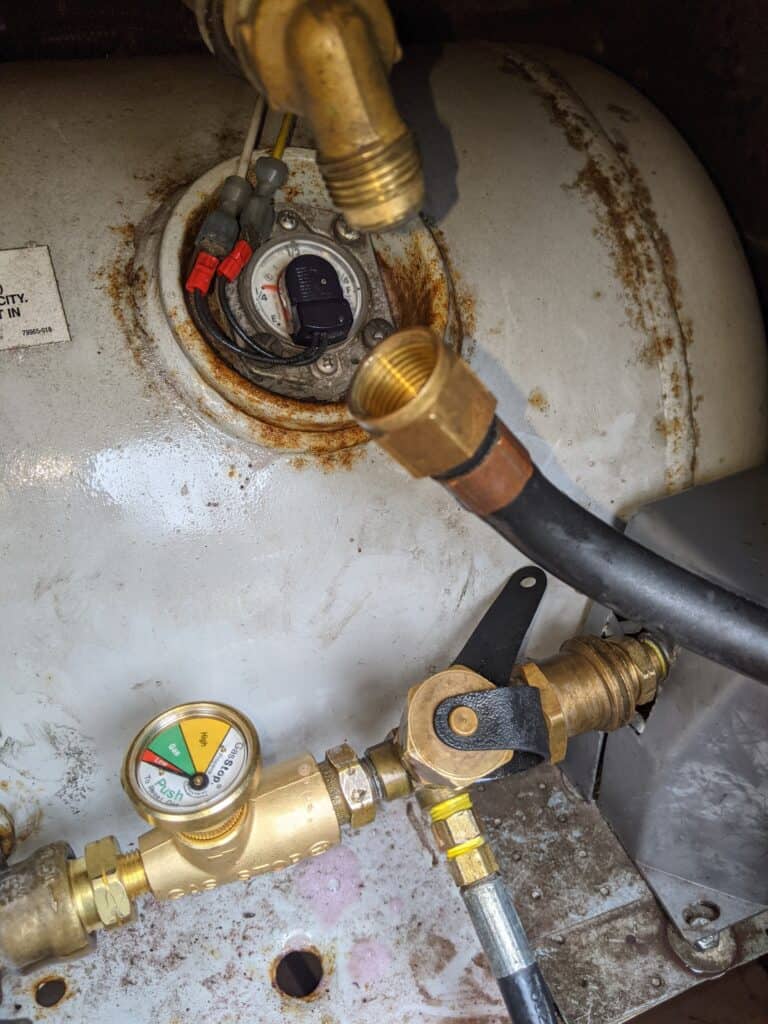
Final thoughts
I wanted to find something I didn’t like about this product to make a pro and con list or give the manufacturers something to change, but I honestly couldn’t. The GasStop is well built, easy to install, and works.
I love the fact that the gauge is active and reflects the pressure going through the line. I also love that it provides an excellent way to check my propane system for minor leaks during my regular maintenance routine. Best of all, I know that GasStop will safely shut off my propane system before it can cause further problems in the event of a major leak.
I will be using GasStop to help keep my family and my RV safe going forward. As a full-time RVer who has lived and traveled in a motorhome for over six years, I also recommend GasStop as a propane safety device for every RVer.
Check out the video below and GasStop’s site to learn more.https://www.youtube.com/embed/0mZLPuQK7hc?feature=oembed
See also:
Levi Henley and his wife, Natalie, workamp around the country in their 26-foot motorhome. Along with writing for RV magazines, they recently published their first book together, Seasonal Workamping for a Living: How We Did It. They share their experiences and RV-related tips on their own blog henleyshappytrails.com as well as videos on their YouTube Channel, also called Henley’s Happy Trails.
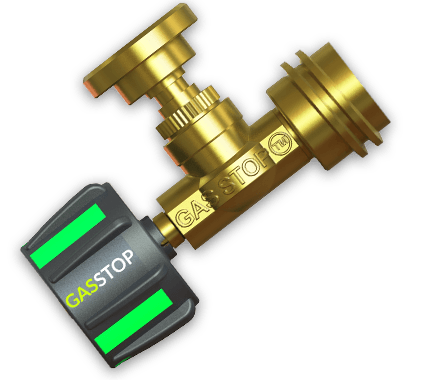
Get your GasStop today
GasStop is available to buy at the online and physical stores shown below.
Get the correct type: POL for motorhomes — ACME for 5th wheels and trailers.













